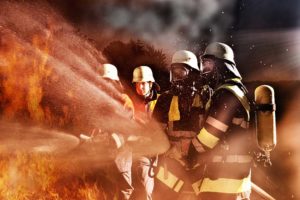Disclaimer: The information on our website is provided for general information purposes only. We make no representations or warranties of any kind, express or implied, about the completeness, accuracy, reliability, suitability or availability with respect to the website or the information contained on our website for any purpose. Any reliance on such information is therefore strictly at your own risk and we are not liable for any damages or losses arising out of or resulting from your reliance on any information contained on our website.
A firefighter responds to fire and medical emergencies and most importantly, fight fires, and helps evacuate people and animals. Additionally, they are usually the first responders and work closely with other emergency personnel when they arrive on scene. They are also skilled to handle medical emergencies and what to do if there are hazardous materials involved. Watch a video to learn what a firefighter does:
How to Become a Firefighter
Step 1: Complete your Education to Become a Firefighter
You must earn your high school diploma or equivalent and then apply to attend a vocational certification program, associate, or bachelor’s degree program in fire science. The length of time it takes to become a firefighter will depend on which educational program you choose. You’ll also need to gain your emergency medical technician (EMT) certification so you can provide first aid on the scene.
Step 2: Pass your Tests to Become a Firefighter
Firefighters must be physically and mentally tough so you will also need to pass a written test, a psychological evaluation, and a fitness test. In addition to this, you’ll also be interviewed. The fitness test is called a Candidate Physical Ability Test (CPAT) and is provided by licensed agencies. According to the Firefighter Candidate Testing Center, this physical test consists of accomplishing eight activities on a course: stair climb, hose drag, equipment carry, ladder raise and extension, forcible entry, search, rescue drag, and ceiling breach and pull.
Step 3: Join a Fire Station as a Firefighter
Competition to join a fire station can be tough. Working at a volunteer fire department can help and provide you with letters of recommendation. Some firefighters will gain additional medical experience and become a paramedic to improve their application as paramedics are able to provide additional medical services than EMT’s. Once you join a station, you’ll attend your fire department’s academy for hands-on experience so you can be prepared to fight fires in your community.
Job Description of a Firefighter

Firefighters typically work at a fire station when not on an emergency. They sleep and eat there and remain on call during shifts of possibly up to 24 hours. The work is considered dangerous and long hours are often required. Also, they must be physically fit in order to lift, climb, move heavy objects, run and balance.
Firefighters must be able to get important information through strong listening and communication skills. Additionally, they have to be quick to recognize a potential problem. Firefighters must also be able to communicate valuable information to co-workers, supervisors, or medical and police people. The competition is strong and physically fit people with high test scores in addition to paramedic training would hold an advantage in this job market.
Firefighter Career Video Transcript
Courage, strength, and a cool head under pressure are some of the most important qualities needed by firefighters. Firefighters control and put out fires, and respond to crisis situations where life and the environment are at risk. Firefighters enter burning buildings to extinguish fires and rescue people, sometimes carrying them. They connect hoses to hydrants, operate pumps, climb ladders, and use other tools to break through debris. The majority of calls they receive are for medical emergencies, so many firefighters also provide medical attention.
Some firefighters clean up hazardous materials, such as oil spills and chemical accidents, while others are specially trained to control forest fires. Most firefighters work for local governments. Some work for federal and state governments, or at airports, chemical plants, and other industrial sites. Volunteer firefighters serve the same roles as paid firefighters and account for a large portion of the workforce in this field. Firefighters’ schedules are typically on duty at the fire station for 24 hours at a time, then off for 48 to 72 hours.
Wildland firefighters may work for extended periods to get a forest fire under control. Firefighters have one of the highest rates of injuries and illnesses of all occupations. They must wear heavy, hot protective gear. Firefighters typically need a high school diploma, valid driver’s license, and an emergency medical technician certification. Candidates must successfully complete interviews, written and physical fitness tests, fire academy training, and, once hired, they must pass random drug tests.
Article Citations
Bureau of Labor Statistics, U.S. Department of Labor, Occupational Outlook Handbook, Firefighters.
National Center for O*NET Development. 33-2011.00. O*NET OnLine.
Firefighter Candidate Testing Center. Candidate Physical Ability Test.
The career video is in the public domain from the U. S. Department of Labor, Employment and Training Administration.


